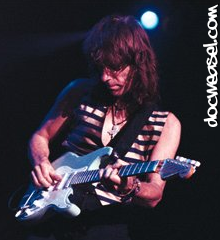Beck proved that a guitar could replace vocals, and project just as much expression, soul, feeling and depth to carry an album. In fact, it melded more easily and distracted less from the other instrumentalists and guitar rhythm textures.
Jeff Beck/Blow by Blow, Wired and with Jan Hammer Group Live
In the mid-70’s Jeff Beck formed a band with some premier sidemen and invented a genre and a blueprint for hundreds of guitar-gods. An all instrumental, guitar-driven, jazz-rock fusion project.
Over the next several years he produced some of the most influential and innovative music, commercially successful and critically acclaimed, and all without the focus of pop music, a vocal track. His guitar was the lead voice, supported by virtuoso musicians playing rocking yet elegant arrangements of great compositions.
Here’s a rundown of the first and probably best known 3 of those albums.

Blow by Blow (1975)
featuring Max Middleton, Phil Chenn & Richard Bailey
BUY IT on Amazon
1. You Know What I Mean
2. She’s A Woman
3. Constipated Duck
4. AIR Blower
5. Scatterbrain
6. Cause We’ve Ended As Lovers
7. Thelonius
8. Freeway Jam
9. Diamond Dust
Originally released in March, 1975, Blow By Blow was a radical departure from Beck’s previous records. After stints with Rod Stewart and Jeff Beck Group, playing mainsteam rock in support of a lead vocalist, Beck took an entirely new direction.
Jazz influenced arrangements of songs by Beck and the band, Stevie Wonder and Lennon/McCartney were produced and orchestrated by the legendary George Martin.
The result was an eclectic mix of funk-rock beats, acid-rock guitar, jazz bass licks and Middleton’s funky clavinet and Fender Rhoads, with a brooding and moody string backdrop that was both classic and original. Amazingly for an instrumental album, with went platinum and spent 25 weeks on the Billboard album chart, peaking at number 4.
Echoes of Blow by Blow can be heard on every guitar-slinger showcase since, spawning the likes of Eric Johnson, Steve Vai, Joe Satriani and hundreds of other Mr. Varney prodigies.
Wired (1976)
featuring Max Middleton, Jan Hammer, Richard Bailey, Wilbur Bascomb & Narada Michael Walden.
BUY IT on Amazon
1. Led Boots
2. Come Dancing
3. Goodbye Pork Pie Hat
4. Head For Backstage Pass
5. Blue Wind
6. Sophie
7. Play With Me
8. Love is Green
Where Blow By Blow had been very much an ensemble album, Beck’s next release, Wired, was a more personal and introspective album. Instead of extended jamming and vamping on funk beats, Wired was more melodic and the lead lines were more pronounced and dominant, with less rambling soloing.
The compositions were tighter and more focused. Narada Michael Walden’s beautiful compositions were perfect vehicles for Beck’s emotional phrasing and feel. Jan Hammer contributioned the most memorable tune, the soaring Blue Wind.
A bluesy rendition of Charlie Mingus’ jazz standard Goodbye Pork Pie Hat showcased Beck’s grasp of dynamics and pacing. On songs like GPPH and Sophie Beck showed incredible touch and feel, sometimes barely touching the strings, then squeezing searing bends and squeals out of his strat.
Originally released in May, 1976, Wired also went platinum and spent 25 weeks on Billboard’s album chart, peaking at number 16.
Jeff Beck
with Jan Hammer
Group Live (1977)
with Jan Hammer, Tony Smith, Fernando Saunders, & Steve Kindler
BUY IT on Amazon
1. Freeway Jam
2. Earth (Still Our Only Home)
3. She’s A Woman
4. Full Moon Boogie
5. Darkness/Earth in Search of a Sun
6. Scatterbrain
7. Blue Wind
Backed by Jan Hammer’s band of hotshot session wizards, Beck only had to stand up and play while behind him the tight and funky rhythm section pulsed out powerhouse renditions of new original tunes and highlights from the two previous albums on 1977’s Jeff Beck with the Jan Hammer Group Live.
The album bristles with peaks, like Steve Kindler’s jazz violin on Scatterbrain, doubling Beck’s blistering guitar line, and the screaming solos and jam sections, between the valleys of ambient moody keyboard pieces like Darkness and Earth (Still Our Only Home), and the swampy funk of Full Moon Boogie.
Beck mostly sticks to playing “colors” and soloing over the band’s arrangements, but it works beautifully. While impressive and spirited, without the fire of his guitar the songs and playing of the sidemen would be without the focus and depth Beck provides.
Only a band as competent and talented as Hammer’s could provide the support to Beck’s loose and rangy style. A perfect balance, although their are a few uncomfortable vocal moments that make you wish he had stuck to his all instrumental format.
Perhaps Beck felt an all-instrumental show wouldn’t hold the crowd’s interest. Whatever the reason, they provide the only weak point to the entire album, which succeeds on every other level, Hammers multi-layered keyboards more than filling out and filling in for Walden and Martin’s string arrangements.
Long before the time with Jan Hammer Group Live went platinum Beck proved that a guitar could replace vocals, and project just as much expression, soul, feeling and depth to carry an album. In fact, it melded more easily and distracted less from the other instrumentalists and guitar rhythm textures.
The melodic lines were just as memorable and strong, both the stacked lead lines and the gentle, solo guitar melodies were full and powerful. Beck didn’t just noodle over his backing band’s groove, in the studio and live he melded with it, producing music that was technically proficient and impressive, but full of feeling and expression.
None of the imitators since have really improved on the original master. And he also provided the solution to every lead guitarist who was sick of dealing with the asshole lead singer.



